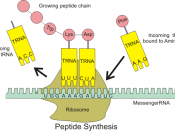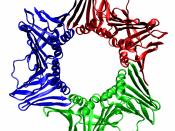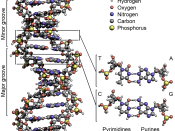DNA are nucleic acids that are made up of long units of called nucleotides. A nucleotide consists of three parts, a nitrogenous base, a sugar, and a phosphate group. Each nucleotide is represented by an A, T, G, or C to stand for the type of nitrogenous base that particular nucleotide contains. The nitrogenous bases that are contained in DNA are adenine, thymine, guanine, and cytosine. The sugar group that is attached to the sugar-phosphate backbone is deoxyribose. Each nucleotides will link to another corresponding nucleotide in the DNA molecule, A with G, T with C, etc. These linkages form what seem to resemble the rungs of a ladder. Moreover, DNA molecules are a double-helix structure, in that, the rungs of the ladder appear to be twisted.
DNA duplicates in a process called DNA replication. This process involves the separating of a DNA molecule into two different strands and starts at specific sites of the double helix called origins of replication.
Each of these strands serves as a template to assemble a new, complementary strand. The result of DNA replication is two identical double-stranded molecules of DNA. This process is called semi-conservative replication, and yields a new double-helix DNA molecule consisting of a single strand of old DNA, with one single strand of a newly replicated DNA.
Throughout replication, the DNA helicase unwinds the DNA helix, which then
forms a Y-shaped replication fork. The single stranded DNA binding proteins then attach to each strand of the uncoiled DNA to help maintain their separation. A group of enzymes also help the DNA replication process by breaking and rejoining the double helix, which allows the twists to unravel and prevents the formation of knots. DNA polymerase attach nucleotides to the 3' end of the strand. Another enzyme called DNA ligase attaches the...



BRILLIANT
Excellent information in one essay clearly detailed and explained in the simplest form which makes it very easy to understand, even with no prior knowledge of the subject. I think this is a great essay and would recommend anybody wanting knowledge of DNA to read this...
5 out of 5 people found this comment useful.